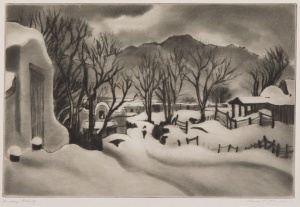This week’s post was written by Hillarey Dees while she was a student in History of Twentieth Century Art.
In the early to mid-twentieth century, Taos became known as a place where European and American modernist art came together. By the 1950s, Taos was one of the few active centers of modernist art in the United States. Many artists painted in Taos because it was a good place to work without the bright lights of big city distractions. The Taos Moderns were showing their creations together, but were not organized formally (as the Taos Society of Artists was earlier in the century). Gene Kloss was working and showing at this time but is rarely mentioned in the context of this group because she was much younger than the rest of the crowd.
Kloss was born in Oakland, California, in 1903. She studied art at the University of California, Berkeley, and graduated with honors in 1924. She continued her studies at the California School of Fine Arts until 1925, when she married poet and composer Phillip Kloss, whom she considered her “creative partner.” It was on a camping trip during their honeymoon that she discovered her artistic inspiration. She had taken a portable printing press with her and set it up next to her tent in the valleys of New Mexico. Her subsequent depictions of Taos landscapes and cultures launched her career.
In January Evening, an aquatint made in 1944, Kloss used the image of a snow-covered valley in New Mexico. The composition is traditionally academic, with a foreground, middle ground, and background. Kloss, like other modern artists at the time, experimented with eliminating the nonessential elements. She used simplified, smooth forms to represent the landscape while still being able to depict its true beauty. The form of printing she used, drypoint and aquatint, let her emphasize the drama of the winter scene with high contrast. This technique created wonderful tonal effects that worked well for the shadows of the drifts in the snow. Like most of her work, there is a sense of mystifying luminosity. The glowing effect captures an essence of the time and place without being a realistic depiction.

